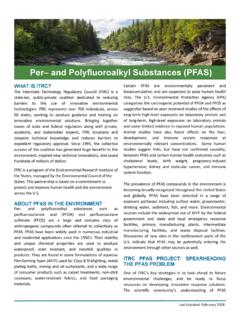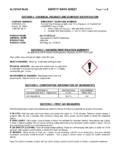Transcription of Compound Specific Isotope Analysis Fact Sheet - ITRC
1 Compound Specific Isotope Analysis EMD Team Fact Sheet November 2011. This fact Sheet , developed by the ITRC Environmental Molecular Diagnostics (EMD) Team, is one of 10. designed to provide introductory information about and promote awareness of EMDs. Please review the Introduction to EMDs Fact Sheet along with this one. A glossary is included at the end of this fact Sheet . Why is Compound Specific Isotope Analysis relevant? Compound Specific Isotope Analysis (CSIA) is an analytical method that measures the ratios of naturally occurring stable isotopes in environmental samples. As described in this fact Sheet , CSIA can be used to gain information ( , potential contaminant sources, extent of degradation, comingling of contaminant plumes) relevant to environmental remediation decision makers.
2 Stable Isotope probing (SIP), which is a separate and distinct EMD method and is discussed in its own fact Sheet , uses isotopically enriched (labeled) contaminants and examines the incorporation of stable isotopes into biomolecules and by- products that are generated during biochemical processes associated with contaminant biodegradation. What does CSIA do? CSIA is a laboratory method in which samples collected from the field are analyzed to give information that can be valuable for assessing environmental forensics or contaminant fate. Each element in a Compound has a distinct isotopic ratio. For a given element the isotopic ratio is known to within a few percent; however, that ratio can change in systematic ways during the course of biodegradation or other processes.
3 CSIA measures these small changes in isotopic ratios very precisely. Those changes can be exploited to gain important information about the source, transport, and fate of a Compound . Table 1. includes information about environmentally relevant elements to which CSIA is often applied. Since the isotopic ratio in the Compound is a function of the starting Table 1. Environmentally material and the manufacturing process as well as the degradation relevant ratios for CSIA. of that Compound after it was made, CSIA has applications in Atom Ratio 2. environmental forensics, biodegradation, and abiotic degradation. Hydrogen H/1H (D/H). 13. Examples include the following: Carbon C/12C.
4 15. Nitrogen N/14N. Biodegradation Oxygen 18. O/16O and 17O/16O. o Apparent cis-dichloroethene (cis-DCE) stall: Is the cis-DCE 37. Chlorine Cl/35Cl biodegrading, or are concentration changes the result of dilution? o Dense, nonaqueous-phase liquids: Is there biodegradation? o Biodegradation of methyl tert-butyl ether (MTBE): Is it occurring? o Aerobic cis-DCE and vinyl chloride (VC): How do we prove progress without daughter or end products? o Cometabolic degradation of chlorinated ethenes: Will the accumulation of VC really be skipped? Environmental Forensics Especially when combined with other tests, CSIA can reveal detailed information not just about remedial progress or remedial potential but also about forensic issues such as the potential for multiple sources.
5 O Methane: From shallow biodegradation or pipeline gas? o Perchlorate: Is it natural or synthetic? o Volatile organic compounds (VOCs): Origin from one source or multiple sources? o Nitrate: Is it runoff or naturally occurring? Abiotic Degradation o Is biogeochemical transformation occurring? o In situ chemical oxidation (ISCO): Was the ISCO successful in destroying contaminant mass and the rebound is really just newly desorbed product? o In situ chemical reduction, iron wall, nanoscale iron, or other reducing mixtures: Has the contaminant been destroyed or displaced? 1. Compound Specific Isotope Analysis (CSIA) EMD Team Fact Sheet November 2011. How are the data used?
6 CSIA can be used to make informed decisions for site characterization, monitoring, remedy selection, and closure. CSIA can differentiate between degradation of a Compound ( , ISCO) and other processes that can also reduce contaminant concentration but do not reduce contaminant mass ( , displacement or dilution). CSIA has also been used to distinguish contaminant sources ( , trichloroethene [TCE] from different plumes). Example Environmental Remediation Questions CSIA Can Help Answer Site Characterization o Has biological or abiotic degradation occurred? If so, how much and where? o Is methane from near-surface biodegradation or natural gas production? o Is the TCE a parent from one source or a daughter product of perchloroethene (PCE).
7 From another source? o Is there evidence of multiple sources? o Is the contaminant in the dissolved or nonaqueous phase? o Is there evidence of a rate-limiting step ( , accumulation of contaminant intermediates)? Remediation o Is monitored natural attenuation (MNA) feasible? Monitoring o Is remediation progressing as planned? CSIA has been in use for more than two decades since the merger of two 50-year-old techniques that were each well established: gas chromatography and isotopic Analysis . Isotopic Analysis has been used extensively in geology and petroleum exploration. Due to the extremely dilute concentrations typically encountered in environmental samples (as compared to those from traditional geology and petroleum exploration applications), the early methods were not suitable for environmental work.
8 However, within the last 10 12 years advances in analytical instrumentation have resulted in the ability to apply CSIA to very dilute samples, and the technique has been broadly applied to evaluate environmental questions. How does it work? Changes in isotopic ratios are caused by the breaking of bonds between atoms. Physical processes such as dilution, diffusion, and volatilization do not change the isotopic ratios in compounds to the same extent as chemical or biochemical processes such as degradation. For VOCs in groundwater, this means that degradation of a Compound is, by far, the major cause of significant changes in isotopic ratios. This change in isotopic ratio happens in both biological and abiotic reactions, and CSIA is used to measure those changes.
9 The CSIA laboratory method is implemented using a number of instruments, including a gas chromatograph (GC) and an Isotope ratio mass spectrometer (IRMS). Because compounds are made up of multiple elements, CSIA can be performed on multiple isotopes to gain further insight into origin or mechanisms of degradation. For example, both carbon (13C/12C) and hydrogen (2H/1H) are often used for MTBE, whereas chlorine (37Cl/35Cl) as well as two isotopic ratios of oxygen (18O/16O and 17O/16O) are often used for perchlorate. Table 1 lists environmentally relevant ratios on which CSIA can be used. Every contaminant is made of atoms of various elements. The isotopes of a given element ( , carbon, hydrogen, chlorine) have the same number of protons and electrons but a different number of neutrons and thus different atomic mass.
10 Each element has a most-abundant Isotope (for example, 12C, or carbon- twelve, for carbon) and one or more less-abundant isotopes (13C, or carbon-thirteen, for carbon). (Figure 1). The less-abundant isotopes are sometimes heavier ( , contain one or more extra neutrons). Some of these heavier, less-abundant isotopes are nonradioactive ( , stable), and the only significant difference between these isotopes and their more-abundant counterpart is the increased mass. The 2. Compound Specific Isotope Analysis (CSIA) EMD Team Fact Sheet November 2011. increased mass leads to the process called isotopic fractionation. Isotopic fractionation is monitored by measuring the isotopic ratio, , by CSIA.



